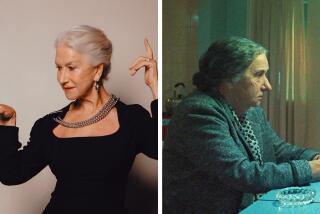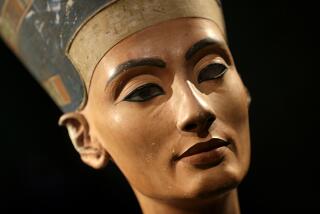In the World of Psychology, the Eyebrows Surely Have It
- Share via
In nearly all of Jim Carrey’s movies, the rubber-faced actor’s eyebrows leap like caterpillars on amphetamines.
Jack Nicholson’s eyebrows arch wildly to imply devious deeds are afoot.
Even Bob Dole, known for his expressly unanimated speaking posture, has been known to cock an eyebrow to italicize his remarks.
The “eyebrow flash” is shorthand for any number of nonverbal messages, adding emphasis like a facial exclamation point or question mark, according to psychologists, sociologists and ethologists. Raised brows also are used to flirt, to express agreement, surprise, fear, disbelief or disapproval, and to send a silent greeting.
But how do we know which message those bouncing brows are meant to convey?
The expression must be interpreted in context, say psychologists, who add that fear and surprise are two emotions that elicit the eyebrow flash unconsciously. In some cases, people totally unfamiliar with a gesture may accurately decode its meaning because there is a relationship between its action and what it signifies, writes UC San Francisco psychologist Paul Ekman in “Human Ethology” (Cambridge, 1979). In other words, when a gesture is not arbitrary, “The form [deeply arched brows], rhythm [jerking sharply up] or what the action does [pulls the face back and upward] resembles the message it stands for.” One example: In cases of fear or surprise, the eyebrow flash is part of a facial recoiling.
The eyes, brows and forehead “are more authentic than the lower face, which we use to perform polite smiling and other things,” says Dane Archer, a UC Santa Cruz psychologist and maker of “The Human Face: Emotions, Identities and Masks,” a five-part documentary distributed by UC Berkeley. “If we are trying to mask our feelings, we do it with our lower face. The upper face is under a little less control.”
*
The eyebrow flash is employed in flirting rituals of many cultures including our own, most lecherously by Groucho Marx, whose eyebrows darted with supernatural speed in the presence of a comely woman.
German ethologist Irenaus Eibl-Eibesfeldt observed the eyebrow flash in at least a dozen cultures, documenting examples in girls from Samoa, Papua, France, Japan, four tribes in Africa and in two groups of South American Indians.
“The flirting girl at first smiles at her partner and lifts her eyebrows with a quick jerky movement upward so that the eye slit is briefly enlarged,” Eibl-Eibesfeldt writes in “Ethology: The Biology of Behavior” (Holt, Rhinehart and Winston, 1975). “Flirting men show the same movement of the eyebrow . . . after this most initial, obvious turning-toward the person in the flirt there follows a turning-away.”
The raised eyebrow in American culture “breaks the taboo of sustained eye contact,” says Archer, and “is used in everyday flirting to signal interest in a person and is also used as a tactic in prostitution. If a woman returns a stare and her eyebrows are raised, it means she is interested in you or she is a lady of the evening.” (Better watch those brows, gals, lest you give a guy the wrong idea.)
Raising the brow as a message of agreement, usually accompanied by head nodding, was documented by Charles Darwin among the Dyaks of Borneo and among Abyssinians, who throw the head back and raise their brows for an instant. Eibl-Eibesfeldt noted the same thing among Samoans, whose arched eyebrows double as a verbal “yes.”
The reverse is true among Greeks, for whom the eyebrow flash is a message of disagreement or a “no.” Eibl-Eibesfeldt recorded the posturing among Greeks, who raise the hand, throw the head back, roll the eyes and arch the eyebrows.
*
In Europe and America, raised eyebrows also are an expression of disapproval. (As in, “For that, I am going to kill you later.”)
Raised brows are part of a catalog of expressions exhibited naturally by newborn babies, who when their head is bent forward deeply, respond reflexively with raised eyebrows, widely opened eyes and neck movement. Even blind children exhibit the response.
Other researchers found that children also arch their eyebrows when searching for something and when looking up at an adult, as if to increase their visual capacity.
Take Nicholson, whose eyebrows are best remembered for their starring role in “The Shining.” (Remember his “He-e-e-e-re’s Johnny”?) Ekman has noted that villains in melodramas pull one eyebrow up and one down to telegraph evil thoughts. (Remember John Belushi’s devious samurai character?)
“If you do Jack Nicholson eyebrows, ‘evil’ is what people think of,” says Jinni Harrigan, a Cal State Fullerton professor of psychology who has studied nonverbal communication. “It is hard to say if we are just programmed to think of that because of the roles we have seen him in.”
Or if fiendish thoughts equal fiendish brows.






